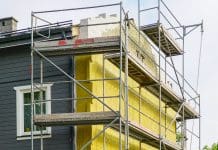PBC Today caught up with Andrew Orriss after this year’s UK Construction Week, examining the current and coming impact of the Future Homes Standard
Andrew Orriss’s career in construction stretches over three decades. As well as running his own consultancy, he provides services to the Structural Timber Association as management consultant.
At this year’s UK Construction Week at London’s ExCel centre, Andrew took part in a panel at the Offsite Hub, ‘Decoding the Future Homes Standard: Navigating Revisions and Implications’.
Afterward, he caught up with PBC Today to reflect on the discussion.
How was your experience of UK Construction Week?
As you can probably tell by the grey hair, I’ve been to a few of those things now over the years.
UK Construction Week seems to have evolved now into much more seminar activity on subject matter.
I did manage to catch a couple of the seminars, and obviously I was participating in one on behalf of the Off-Site Alliance. There’s some really helpful seminars if you’re trying to keep pace in a very, very fast-moving industry.
The pace of change within the construction industry is probably at a rate never seen before. There are a number of different drivers around that – perhaps most of all, the pace in which regulations are changing, and the pace in which the Net Zero 2050 agenda is impacting on people’s thought processes.
The Building Safety Act is another challenge that has had a very profound potential impact on the industry.
None of these things are little tweaks to regulations. These are big issues. The industry’s thirst for knowledge on this is quite high, as it tries to keep up with all of those different aspects.
On behalf of STA, that’s where I am in my day-to-day role, actually making sure I’m across those agendas so I can communicate those things to the membership.
What would be your advice to a first time visitor at the event?
Plan. You’ve got to plan. If you don’t have a plan and you meander aimlessly, the chances are you’re going to miss something.
But more importantly, because you’ve got simultaneous seminars going on, you’ve got to be quite harsh with yourself and say “my priority is this subject, this one, this one, and this one. And will they all go? Is it going to be a clash?” Because some of the seminars are going at the same time.
But plan, plan, and plan again.
How was your experience at the panel at the Offsite Hub?
The conference programme was quite good in addressing quite a lot of questions.
The speaker panel I participated in was particularly about the Future Home Standard and where we think it is heading.
It’s obviously still out of consultation at the moment, but there’s been a very strong indication from DLUHC that the Standard will not require any further improvements in the fabric of the building. This is a particular direction of travel that I’m struggling with, and I think probably quite a lot of my members are struggling with.
People are asking why you wouldn’t want to increase the fabric energy efficiency of a home, instead of leaning more towards new technology to do the job. I’m a very simple person at the end of the day, and I believe if I want to reduce my electricity bill, I use less.
I think it was the Climate Change Committee that came up with that premise that the houses that we’re building today are insufficiently insulated. We’re building homes today that will need retrofitting with improved fabric in 15 years’ time, which does seem a bit counter intuitive. Why don’t we just do it now instead of considering retrofitting later on?
I think it was a reasonably thought-provoking debate at the panel with interaction from the audience as well – quite a lot of nodding in agreement and quite a few shaking of heads. From that, we can deduce we were stimulating some thought processes, which was the intention.
Do you think the UK construction industry is ready to be compliant with the Future Home Standard?
The Future Homes Hub was asked by DLUHC to initiate an investigation into how you could actually get to where you need to be in terms of energy conservation using load-bearing masonry and timber frame construction.
Given the level of detail, it was over a relatively short period of time. But the result was that the whole industry – house builders, supply chain partners, trade associations – all contributed to the discussion and asked if the standard was going to rise, if it was possible, and if it could be done on a scale.
One of the discussion points in this process was Passivhaus – could you use Passivhaus as a model for the future of our energy conservation standards?
Almost all the housebuilders say, ” We completely understand Passivhaus, but we don’t believe it’s possible to do it on a large scale.”
It’s one thing doing a little community of five or six Passivhaus homes. But if you’re building tens of thousands houses a year, could you build to Passivhaus standard?
The general consensus from the house builders in this process was that it can’t be scaled because it is so dependent on so many critical aspects.
Airtightness, for one. The building’s airtightness has to be extraordinary for Passivhaus, and it requires a level of skill and attention to detail that doesn’t work terribly well with scale.
Another example is that houses on large developments cannot all be orientated in the same direction for solar gain.
The counter argument was this is simply an education process. Well, no, it’s not quite as easy as that, because you’ve got house builders building tens of thousands of houses a year using different technologies, different materials, they require different skill sets and different experiences.
The feeling was that you’d be setting up to fail if you use Passivhaus as the end game to the Future Home Standard.
“But what we were able to do is say, if that’s utopia, where’s the achievable bit?”
This comes to your question, is the industry ready to be compliant with the standards?
I would say yes because, actually, the industry was there in the decision-making process.
What emerged very clearly was that the biggest energy consumer is not space heating but hot water, and technology is available to address this.
For space heating on a lower level of heating demand, you’ve got your voltaics, inverters, and air source heat pumps – which are terrific, but you’ve got a really well-insulated home.
Not so good if you’ve got an old leaky house like I’m living in at the moment.
I was really impressed with the level of appreciation and understanding that even the small to medium-sized housebuilders involved in the process had, which was to lean more into the low energy heating systems and micro generation and so on.
When you look at the industry in the round, I think the housebuilders understand it. Yes, they could be compliant relatively easily. Is the supply chain ready? Not quite in some areas, but are in others.
Actually, what we did find at the Future Homes Hub is that a lot of our members are already building routinely to standards that exceed what’s predicted for the Future Home Standard for 2025.
There’s a lot of work going on in the background to make sure that the industry is ready for when the time comes. I’m very optimistic about that.
Where do you see the strongest need for improvement?
The Future Homes Standard does not address embodied carbon. It can’t. Because we’re not in a place at the moment where we can be absolutely confident about the embodied carbon in the thousands of different components that go into making a house, for example.
It is a huge challenge because we’ve got many organisations beavering away saying they have the solution to embodied carbon calculation. The Royal Institute of Chartered Surveyors is probably the one that’s bubbling to the top at the moment- but that’s got flaws in it.
RICS assumes that a building has a 60-year lifespan. What happens to the building at the end of that life is then factored into the embodied carbon argument. Now, you could argue that 60 years is a bit short.
Arguably, what we’re building today could be flattened in 60 years, although highly unlikely.
Even if we did bulldoze all homes that are 60 years old, this assumption throws all the embodied carbon arguments askew – because they’re all based on the assumption that we’ll do exactly the same in 60 years as we do now in terms of re-using components.
When you consider carbon considerations, the embodied carbon has the more dramatic effect on climate change, not the carbon in use. At some point, it’s got to become part of regulation.
More and more clients are asking for environmental product declarations (EPD), because they’re starting to understand the impact of their embodied carbon.
I don’t think we’ve quite got to a point yet where the EPD will determine what product is being used, but people are actually starting to call for it.
We’re years away from them being mandated and they are actually very complicated. So getting used to them now is actually quite a good thing.
What should we take away from these kind of discussions around the Future Homes Standard and related topics?
I’m not a climate change warrior by any stretch of the imagination, but I do fear for the future. I do believe that if we don’t take steps now, it will be too late. Some may argue that it’s already too late, I generally don’t think it is.
But I think the best results of these changes in terms of energy efficiency and conservation of energy is at least taking us on a journey – albeit not fast enough – of actually recognising the impact that the construction industry has on the climate.
The pace of change is probably moving as fast as it possibly can, if I’m going to be honest. I think an industry that hasn’t really evolved too greatly in many years is now saying, we understand, we have a responsibility and we’re getting behind it. And I think that was really good, really, really good.














